SUSHI-TSU
by Michael Baumgärtner
Preparation
The preparation of Sushi needs as much creativity as craftsmanship. You will need a lot of exercise to learn the main techniques so that the Sushi taste excellent and furthermore look wonderful. Even if you will not succeed in the beginning - after enough attempts the rice will be pressed with the right pressure, the Nigiri-zushi will be oval and even and the Maki-zushi will be round instead of square.
In the first paragraph of this chapter you will find all needed knacks for the preparation of the additions like Wasabi, Gari or Goma. It continues with the right technique for cutting up fish and the important preparation of rice.
Afterwards the production of the different kinds of Sushi - Nigiri-zushi, Maki-zushi, Temaki-zushi, Chirashi-zushi - is described.
What to do first
I advise you to prepare some of the basic ingredients earlier so that the actual making of Sushi works smoothly.
Ginger (Gari)
We can easily prepare pickled ginger by ourselves, as shown in the following recipe. The pickled ginger keeps about six months in the refrigerator.
Pickled ginger
Ingredients
- 4 pieces ginger
- ½ liter vinegar
- 350 g sugar
- salt
Preparation
Peel the four pieces of fresh ginger and cut into thin slices. Put it in boiling water for about one minute - not too long, otherwise it is losing its sharpness - and then strain into a sieve. Rinse with cold water and pat dry. Mix the ½ liter of vinegar with 350 g sugar and a teaspoon of salt, pour with one liter of boiling water. Let cool down the marinade and put the ginger for at least one day into it. Only take out before serving.
Horseradish (Wasabi)
Peel the fresh Japanese horseradish and rub it into mush with a fine grater. Horseradish powder is stirred with water to a thick paste. Green horseradish out of a tube is ready to be used instantly.
Seaweed (Nori)
The seaweed sheets gain taste if roasted. In doing so they also get less tenacious. It is best to pull the Nori briskly over a hot hotplate or open flame. Alternatively you can put the sheets into a hot stove for a moment. The roasted seaweed has a noticeably brighter color than the untreated sheets.
Tip
Nori is often sold particularly for making Sushi. These sheets are already roasted.
Sesame (Goma)
The very aromatic sesame seed gains taste by easily roasting as well. Containing much fat and oil, you can roast it in a pan without further fat. As soon as it turns golden-brown in color, you have to take it out of the pan immediately.
Fish
The Japanese distinguish between two methods to divide fish: sanmai oroshi cuts it into three parts, gomai oroshi into five parts. The second method is only suitable for flat or very big fishes. Being a possibility for us, the first method is described here.
Tip
While cutting fish, you should dip your knife briefly into a mixture of cold vinegar and water every second or third cut. Therefore the fat of the fish will not stick to your knife.
To get rid of the scales, take the fish by its end. Put the knife flat to the fish and scrape off the scales in direction to its head. Do not hold the fish by its body to maintain the stability of its flesh. While scraping, rub the fish with salted water from time to time.
Cutting into three parts (Sanmai oroshi)
Using this method, we have left three fish parts: One fillet left, one right and the skeleton.
-
To remove the head, lay the fish on its side. Put the knife behind the side gills and separate the head crosswise, beginning by the belly.
-
Cut open the belly from the fish's front to its belly flipper. Remove its insides thoroughly and clean the fish in the following, using running water.
-
By putting one hand gently on the fish and cutting with the knife along its back to its end, you get the first fillet. The knife should brush against its chest.
-
Now turn the fish over and remove the second fillet in the same way.
-
In the end, search the fillets carefully for bones and remove them.
Freshwater Eel/Sea eel (Unagi/Anago)
Eel is best bought as fillet. You will only need to marinade and grill the eel as described in the following recipe.
Grilled eel
Ingredients
- Eel fillets
- 3 parts rice wine
- 1 part sugar
Preparation
For the marinade mix three parts rice wine with one part sugar. Cut the eel fillets into two or three pieces. Grill at first the skinned side, eventually the other side. Steam the pieces about 5 minutes over intense heat and spread on the marinade. While finally grilling the eel once more, spread marinade on.
Other seafood
Abalone (Awabi)
In contrast to many other mussels that are only eaten at certain seasons, the Abalone may be eaten throughout the whole year. Make sure that the Abalone is alive just before you prepare it. It is the only way to use it raw for Sushi. If you touch the mussels's flesh and it contracts, you can be sure it is alive.
The suction foot of the Abalone is the eatable part. Detach it from the shell and clean it with a brush and much salt. Rinse it off with running water. Take a sharp knife and remove the dark edges around the flesh. In the following, cut the suction foot in angular slices.
Squid (Ika)
In order to remove the tentacles and intestines of the squid, we seize the tentacles firmly with one hand at their basis, pulling the body strongly with the other hand. After separating the tentacles we carefully remove the fins. Finally you have to get rid of the outside skin of the squid's body. We do not use the intestines, fins and skin. Wash the squid's body and dry it off a little before you cut it in slices.
Tip
I advise you to rub your hands and the squid again an again with salt to make it skid-proof. The raw pieces of squid are very firm to bite. Therefore cut the slices with a sharp knife in a rhombic way.
Shrimps (Ebi)
The size of the shrimps for Sushi should be about 5 to 6 centimeters without head. First we remove the heads of the shrimps and wash the bodies off very thoroughly. Detach the intestines and spear the shrimp between shell and joint on a small skewer so that it remains straight when cooking. Boil water in a pot and put the shrimps in. The shrimps are done if they rise to the surface. Rinse with ice-cold water immediately and detach the skewers. Remove shell from around body, but not tail. Cut the shrimps open along belly only going halfway in. Open out and flatten the shrimps with your fingers.
Rice
The rice concerning Sushi has a completely special meaning and therefore its preparation, too. The well-done Sushi rice should be sticking easily so that you can form small bites that do not fall apart immediately. On the other hand, the rice should melt in one's mouth without having to be crushed, or worse, bitten to pieces.
The best way to reach this is to prepare Sushi rice traditionally: We steam the rice, blend it afterwards with spiced vinegar and cool it down as fast as possible to body temperature.
Begin about one hour before you want to cook the rice with washing it. Put cold water in a bowl and add the rice. By stirring, any residues come off the rice corns. Pour off the clouded water and replace it with fresh water. Repeat this procedure until the water comes clear. Subsequently, pour off the water and let drain and rest the rice at least half an hour.

Now we need a pot with a tight-fitting lid. Put the washed rice together with water and a Kombu-stripe in the pot and bring it with closed lid to the boil over a medium heat. For one cup of rice use about one and one fifth cup of water. Remove the seaweed just before the boiling point. As soon as the rice is cooking, let simmer and steam the rice for about 10 minutes. During the whole procedure you should not lift the lid of the pot.
Meanwhile you can prepare the spiced vinegar. A good basis for spiced vinegar is the following recipe. It is sufficient for approximately five cups uncooked rice.
Spiced vinegar
Ingredients
- 8 tablespoons rice vinegar
- 4 tablespoons sugar
- 1 teaspoon salt
Preparation
Stir all ingredients as long as salt and sugar have dissolved. To adapt the spiced vinegar to your own taste, it is best to change the amount of sugar.
When the rice was steaming for about 10 minutes, take the pot and leave the rice untouched for another 10 minutes, still with closed cover, without heat.
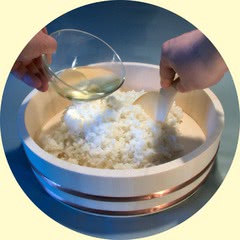
The rice is ready after 25 minutes altogether and should be mixed with the spiced vinegar immediately. Therefore fill the cooked rice into a flat wooden bowl. Add the prepared spiced vinegar and blend with a wooden spatula.
In order to obtain the cooling of the rice as fast as possible you need to cool it with a fan during seasoning.
Nigiri-zushi
For Nigiri-zushi, form the rice by hand to a small oval dumpling, spread on Wasabi and put on fish. It is particularly important to pay attention that the quantity of fish and rice is well balanced.
You need rice, fish and Wasabi; furthermore a chopping board and a sharp knife. Have a bowl of a mixture of vinegar and cold water ready.
-
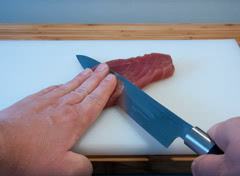
First, cut off some slices of the fish fillet. Lay the fillet across to you on the chopping board. Put the knife on straight, about one and a half centimeters away from the edge. Cut the slice diagonally to the edge.
Now you can form the Nigiri-zushi:
-
Moisture your hands sufficiently with the mixture of vinegar and water.
-
Take some rice with your right hand and form a small longish dumpling.
-
Take the fish carefully with your left hand, putting it on your fingers of your left hand.
-
While keeping the dumpling in your right hand, use your right hand's index finger to spread some Wasabi on the fish.
-
Then put the rice dumpling on the fish.
-
Take your right index finger and middle finger to press the rice carefully against the fish. Fix the rice at the end with your left thumb.
-
Turn the fish on top by changing the Nigiri-zushi from your left to your right hand and backwards.
-
Once again press the fish easily against the rice with your index and middle finger.
During this procedure, it all depends on the facts that you do not form the rice too firmly and not hold the fish too long in your hand.
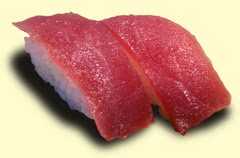
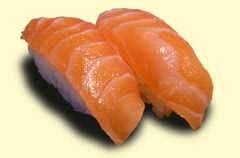
Nigiri-zushi are always served in pairs.
Gunkan style
The Gunkan style makes it possible to prepare Nigiri-zushi with a filling like sea urchin, various sorts of mussels or fish roe. Therefore you wind a stripe of seaweed round the rice dumpling. The so created cup is stuffed with the filling:
-
Moisture your hands sufficiently with the mixture of vinegar and water.
-
Take some rice with your right hand and form a small longish dumpling.
-
Now put the dumpling on the chopping board and press it flat a little.
-
Wind a stripe of seaweed, approximately 3 to 4 cm in width, around the rice.
-
Press flat the rice once more.
-
Now you can fill the covering into the cup.
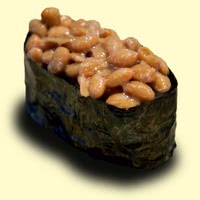
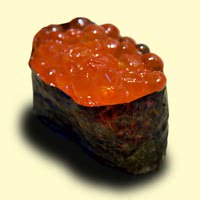

Maki-zushi
For preparing Maki-zushi you need the bamboo mat, the chopping board and a sharp knife. The ingredients are rice, stuffing, seaweed and Wasabi.
First roast the seaweed sheets from one side and afterwards cut it into half. Cut the ingredients for the stuffing in strips. Now you can form the Maki-zushi:
-
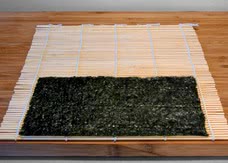
Lay the bamboo mat in front of you on the chopping board. Place half of a seaweed sheet onto it, shining side down. The edge of the sheet should end with the edge of the bamboo mat on your side.
-
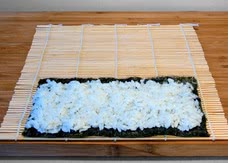
Moisture your hands sufficiently with the mixture of vinegar and water. Take some rice and put it evenly on the seaweed sheet, about half a centimeter in height. Leave a margin of one centimeter in front and at the back.
-
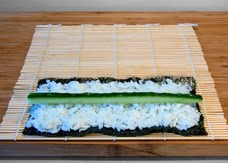
Spread Wasabi across the middle of the rice. Put the ingredients for the stuffing across the rice, too.
-

To form the roll, hold the mat at your side with both hands. Fix with your thumb and index finger the right and left corner of the seaweed. Roll the mat away from you with even pressure.
-
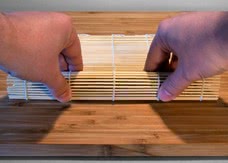
Now compress the roll - still with the mat - firmly with both hands. Fix the ends.
Cut the finished roll with a sharp knife into six or eight equal parts. Therefore cut the roll in half, put the halves side by side and cut them again two or three times.
Tip
For cutting the Maki-zushi I advise you to dip the knife into a mixture of vinegar and cold water before each cut.
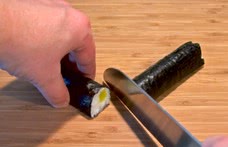
Arrange the Maki-zushi on front side, having the smooth side at the top.
Ura-Maki
This special kind of Maki-zushi is formed like this that the rice sticks outside the seaweed sheet. Therefore spread the rice like described over the seaweed sheet. Then turn the covered seaweed sheet upside down. It is necessary to protect the bamboo mat against the sticky rice by using a cling film. After stuffing and rolling you can carefully remove the cling film. FIXME: Für einen tollen zusätzlichen Geschmack können wir die Ura-Maki noch in geröstetem Sesam oder in Fliegenfischrogen rollen.
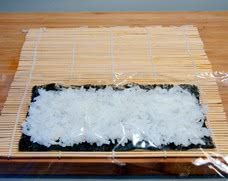
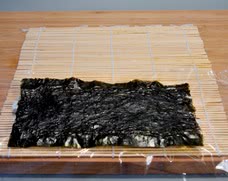
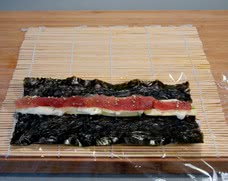

Other Sushi
There are other kinds of Sushi apart from the well-known and traditional Nigiri-zushi and Maki-zushi:
Temaki-zushi
These hand-rolled Sushi are very well suited for the self-preparation at the table. Therefore you prepare the rice and make seaweed, Wasabi and various ingredients for the stuffing available.
While eating, every one makes his own Sushi. Take a half-sized seaweed sheet and spread half a spoon of rice on it. Put a stuffing of your own choice in the middle. After spreading some Wasabi on, roll the seaweed carefully to a cone.
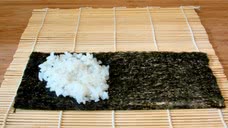
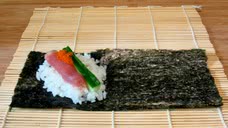
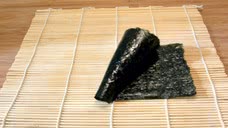
Temaki-zushi should be eaten immediately. Otherwise the seaweed sheet becomes soggy and the Sushi might fall apart.
Chirashi-zushi
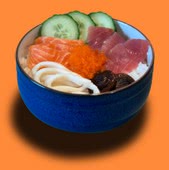
The easiest form of Sushi is Chirashi-zushi: mixed ingredients on top of a bowl of rice. No matter where you eat it, the taste will always be totally different because there are at least as many variations of Chirashi-zushi as there are people preparing it.
One possible variation is: two slices of tuna, salmon and swordfish, two pieces of squid (cooked), one prawn, a piece of omelet, three slices of cucumber, one shiitake mushroom. Prepare ingredients on top of a bowl of rice decoratively.